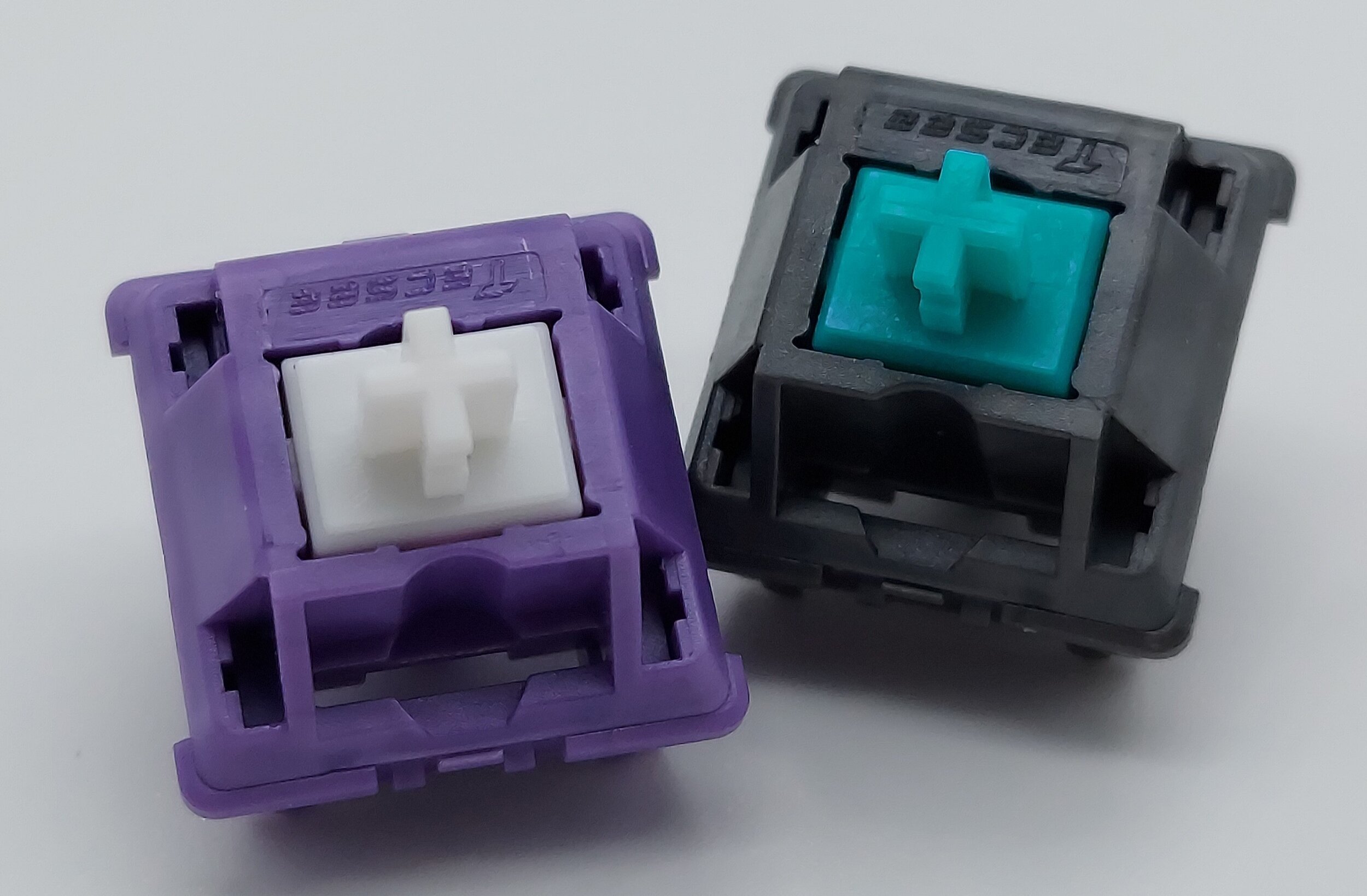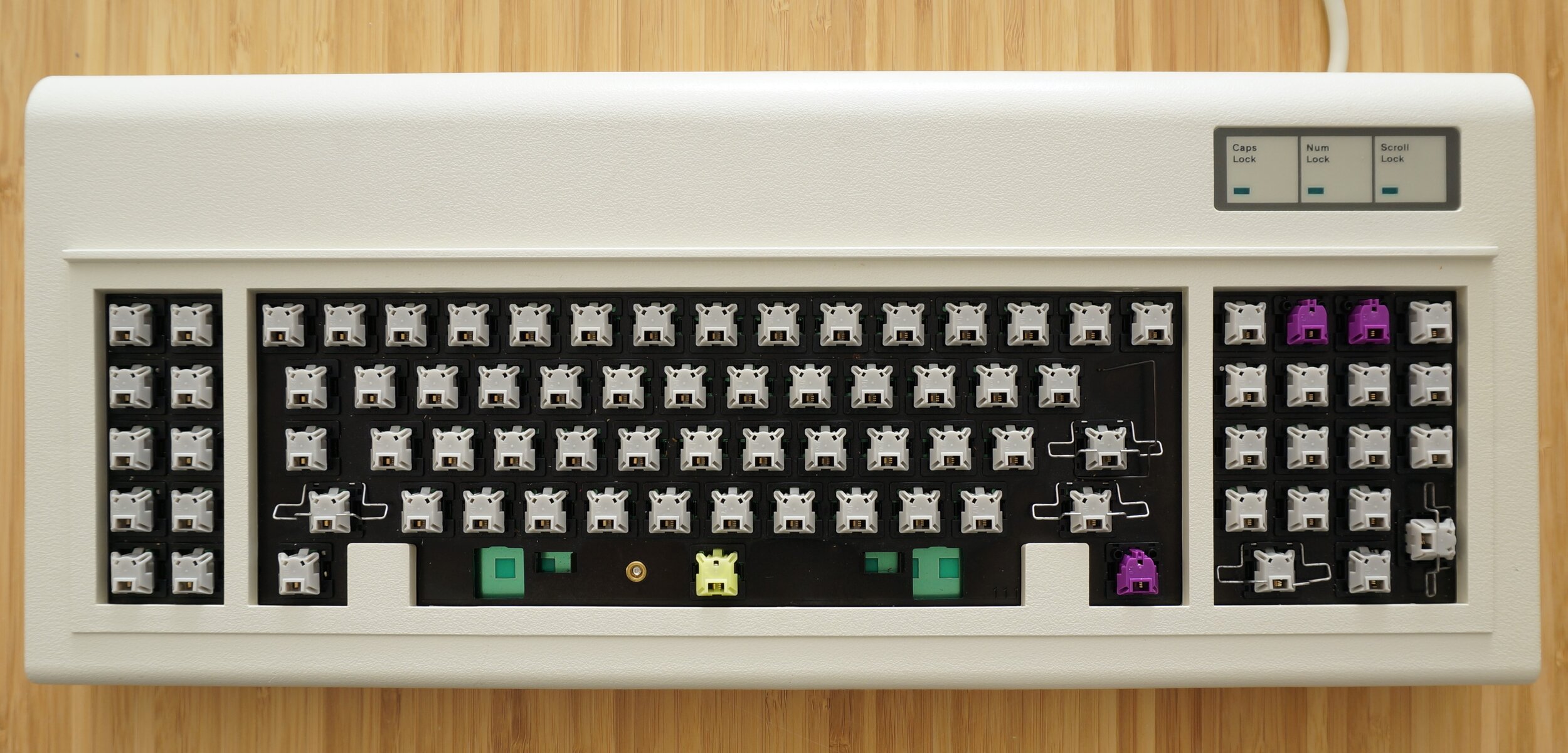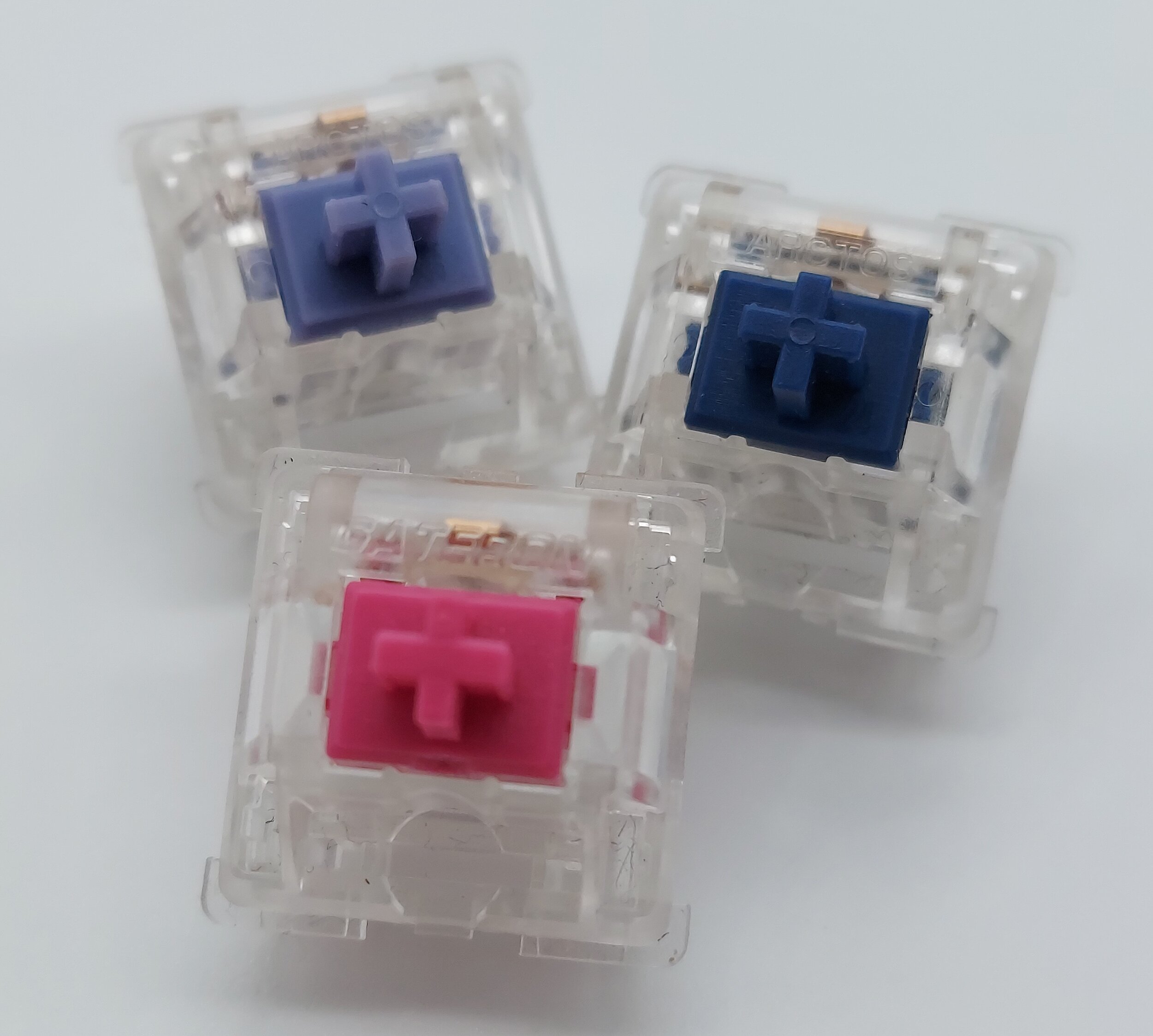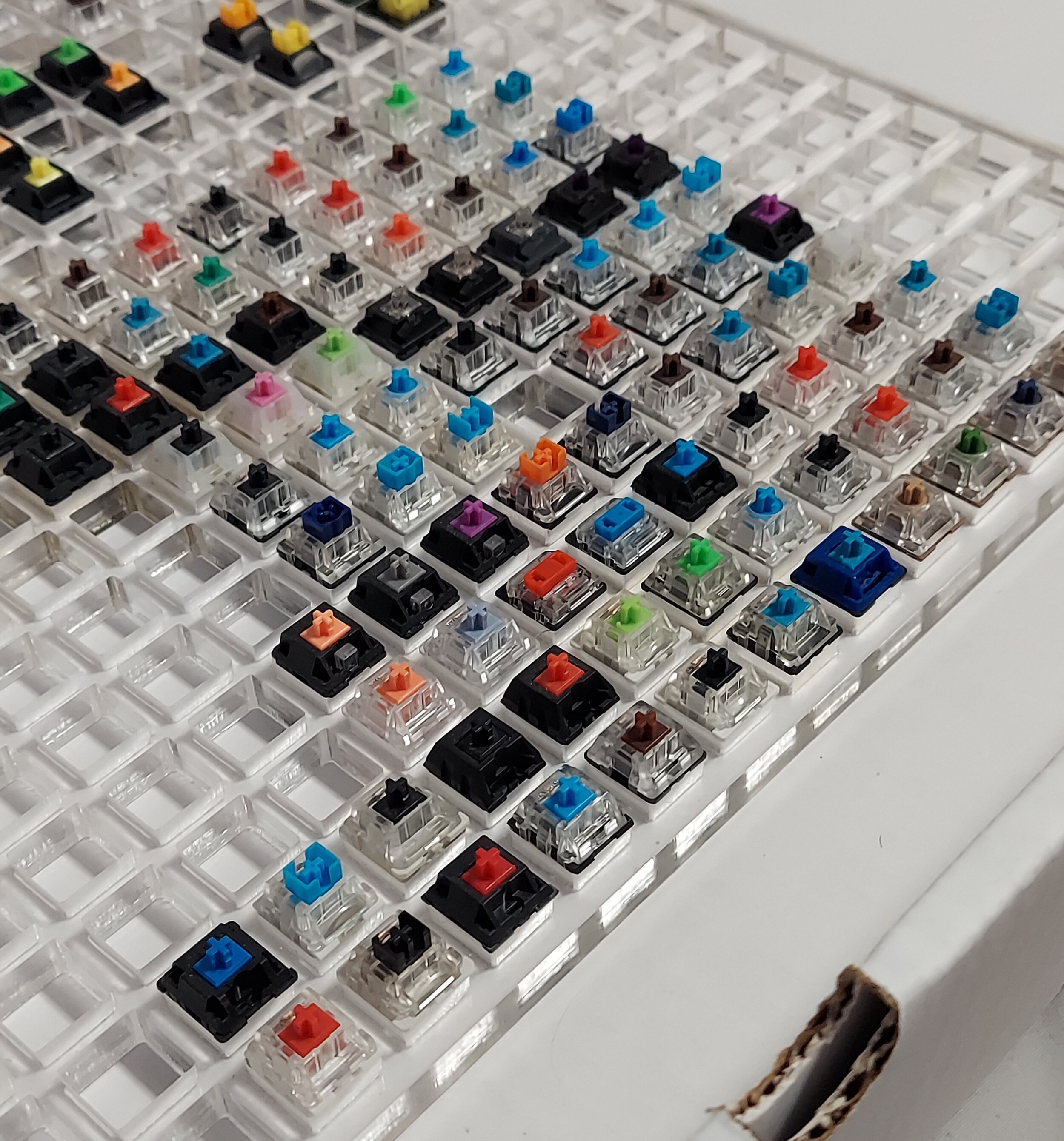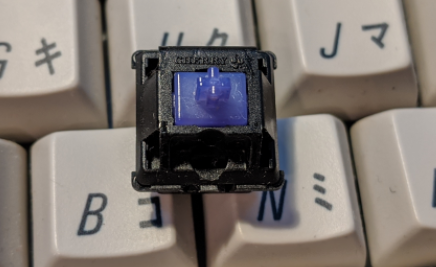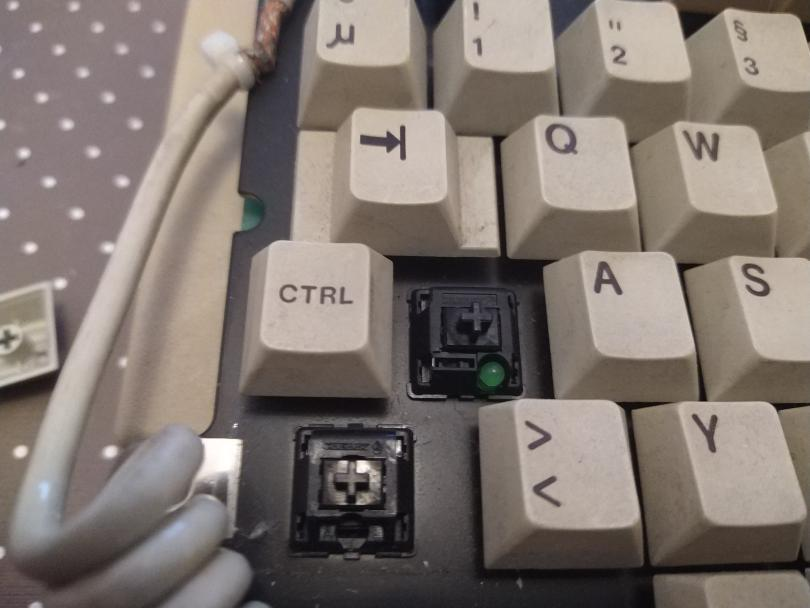25 Switch Details You May Not Know
While normally you all have come to expect a full-fledged review of me every two weeks like clockwork, I would like to start out this alternative article by pointing out that I do like to spice things up now and then with non-review articles. Some of these previous articles include the Pandaverse document (which I am aware that I need to update), the Stealios Controversy, and even an overly data-heavy survey document about Switch Tops. Given that these articles are both fun for me to write and help break up the pacing of reviews, I figured it was about time to sit down and work on one again. However, rather than shouting to the sky about frankenswitches or about why your keyboards never quite sound like your favorite keyboard YouTuber, I was actually struck by a set of recent occurrences that have been happening to me.
Given that I actually genuinely do love switches well past just writing overly verbose documents about them online, you could imagine that I talk about switches all the time. I talk about them to coworkers, non-keyboard friends, my mother, your mother, and even to the voices in my head. Thus, in telling a lot of these stories, I end up getting to toss in little interesting tidbits of information about switches that I simply don’t have any other means of working into a review or a document. As people have more and more recently been showing surprise at some of these details I’m seemingly pulling from thin air, I was kind of interested in compiling some of these ‘throwaway trivia’ facts in some fashion to share with the community at large. Thus, this document has been born to get to share all the little crumbs of knowledge that I actually can’t stretch into a longform review out into the community for you all to know about as well. Or, this could all just be preparation for the ‘Mechanical Keyboard Switch’ Jeopardy category when they finally respond to my repeated inquiries to add it to the show.
Figure 1: Speak for yourselves, but this would be the peak of my entire existence.
I’ll take Mechanical Keyboard Switches, Alex
-1. Matias Orange switches almost happened
Figure 2: Original 2012 Geekhack announcement of Matias Orange switches.
Even though I’ve not covered Alps or Alps mount switches thus far on the website, I’d figure I’d kick this off by talking about one of the most popular modern Alps mount switches from Matias. While many people recognize these as coming in Red, White, and Grey variants, Matias had originally planned for the Grey “Quiet Click” (Tactile) switches to come in an orange color. However, according to their initial announcement thread on Geekhack from 2012, the orange was ultimately not used due to the color dye either not adhering to the plastic well or causing molding issues with their stems. To date, there are no known photos of these Orange Matias switches and according to a brief DM conversation I had with them in 2019, they certainly do not have any physical examples of these lying around any longer.
Original Matias Geekhack Thread
-2. Cherry has ‘Cherry Red’ colored prototypes
Figure 3: Cherry Red Prototype top housing from my personal collection.
While I have previously shown this off on social media as well as to my patrons on Patreon, I’ve never gotten a chance to fully explain where this very unique looking Cherry top housing is from. In surprising fashion given their relatively plain switch design modus operandi, Cherry actually prototypes switches using a ‘cherry red’ colored nylon blend as to make sure they don’t slip out of the facility easily. Even though a few other noted community members, such as famous Cherry collector Unclefan, have managed to get ahold of some of these housings, they are nearly impossible to come by. According to a publicized discussion with a Cherry employee, the only means of obtaining these are through a ‘close relationship with a Cherry employee.’
Figure 4: Cherry Red Prototype switches with stems as seen in Cherry’s Easter 2021 Twitter post.
Wodan’s Cherry MX Red Prototype TX84SE Build
Cherry’s Easter 2021 Twitter Post
-3. PME and JX are not new plastics
Figure 5: Tecsee Kingfishers and Purple Pandas which both have PME housings.
Up until the last year or so of switch releases, alternative materials for switch housings and stems were certainly not a highly explored topic as many companies chose to only stick to the traditional polycarbonate and/or nylon top housings with POM stems. However, with the rise in popularity of switches like Novelkeys Creams, many companies began to explore alternative materials in housings and stems such as POM housings and UHMWPE stems. Even more recently than this, companies have seemingly begun to move into the realm of releasing their own ‘proprietary blends’ of plastics which have a secret, unstated formula, but are likely only a mixture of existing switch plastics in use. While I’ve discussed a good amount of potential thermoplastics that we may see one day in switch materials in my Switch Plastics document, PME and JX are not any known singular, pure thermoplastic material. They are, as described by the companies, to be a proprietary secret mixture of different plastics or potentially plastic fillers. While much more covertly, Gazzew’s Boba U4 switches also boast a secret housing material blend which is assumedly ‘proprietary’ in the same fashion as PME or JX though unstated.
-4. Gazzew’s ‘Black Ice’ Switches were a thing
Figure 6: Gazzew ‘Black Ice’ switches in two different weights from 2017.
While I have quite an exhaustive collection of Gazzew’s stuff as he has been a great friend and supporter of the collection for some time now, one of my more interesting pieces from him comes in the way of his quite old ‘Black Ice’ switches from around 2017. Back when Gazzew first participated heavily in the hobby, he was a Vintage Black harvester prior to transitioning into his work on the ICE switches with Outemu. In the interim between these two phases of his experience, given that it wasn’t a clean cut, there was some overlap in which he had sold Vintage Black stems in Outemu ICE housings under the name of ‘Black Ice’ switches. In addition to these switches that I have gained from another collector, I also have the original invoice printout that shows these switches sold at $1.00 per switch lubed by hand in 2017. Aside the neat moment in history they represent, they also have by far one of my favorite names for switches which is what prompted me to add them to this list.
-5. Mech27 bathed in Invyr Pandas
Figure 7: Mech27 bathing in a batch of V1 Invyr Pands.
Pivoting to another individual responsible for influencing the history of switches, many of you how have read my Pandaverse article will recall that Zisb and Mech27 are the team that originally brought the Invyr Panda switches into existence. Given that I wasn’t around at the time of release of these switches, and the history behind many memes are often obscured a bit due to the ‘inside joke’ nature of them, I don’t entirely have the full context behind this photo above. What I do know, though, is that Mech27 bathing in a batch of Invyr Pandas to be shipped out is at the absolute peak of the list for unique switch release gimmicks I’ve ever seen.
-6. Gateron employees hand inspect switches
Figure 8: Photo from inside Gateron manufacturing facility showing hand inspection of switches by employees.
Very recently, switch manufacturing facilities in China have begun offereing limited tours to select individuals and many of them have returned to ZFrontier with photos of their travels. Specifically, regarding the tour of the Gateron factory, one of the more interesting pictures to arise was that of workers who do manual switch quality checking prior to them being packaged up and shipped out to buyers. This certainly surprised me, and many individuals, as it was assumed that these would be tested by machines en masse or at least not all individually tested by hand due to the sheer amount of switches an employee must test on any given day. Regardless, I now know that I have an actual dream job in life, and am beefing up my resume to apply when they have an opening again in the future.
ZFrontier post of Gateron Factory Tour
-7. Prototype switches are sometimes incomplete
Figure 9: Factory color/material sample tests of Cobalt POM and SP Star GID switches without leaves.
Due to my fortunately close relationship with many switch selling vendors in this hobby, I do get the chance to receive a fair amount of switch prototypes if they have spares lying around. Occasionally, though, rather than receiving full release samples, I will get ahold of material or color samples sent from the factory. While release prototypes are often fully built to be used in keyboards, many people may not realize that the ultra-small color or material batches tested by manufacturers will often see them not putting in any leaves at all to save time and cost. For example, pictured above are a couple instances of this in my collection including my PrimeKB Cobalt POMs, and two SP Star GID color samples that I received as a gift from TKC.
-8. There’s a 4th Novelkeys Big Switch
Figure 10: One-off Novelkeys x Kailh Big Green Switch owned by u/mgsickler.
While most people are aware of the Novelkeys x Kailh Big Switch line, which consists of Dark Yellow, Burnt Orange, and Pale Blue switches that are 64 times the size of normal MX switches, what many people don’t know is that there is actually a fourth Big Switch entry. Being produced specifically for a giant operational Razer keyboard at CES 2018, Razer green colored Big switches were made by Kailh for the display piece and a one-off with matching box was given to mgsickler, the owner of Novelkeys, for being willing to do such. Pictured above is his unique box and display piece that I can only dream of owning at some point in the future.
u/mgsickler’s Reddit post about Razer’s Giant CES 2018 Keyboard
-9. Red and Black Zealios switches existed
Figure 11: The only image in existence of either the Red or Black Zealios V1 prototypes.
While many people new and old alike associate the name ‘Zeal’ with their iconic eggplant, purple-colored switches, the very first prototypes of these switches were in fact not purple, but instead red and black. Made from colors that the Gateron factory had on hand readily at the time, these switches have no existing clear photographs of them and were only briefly mentioned back on one of the earliest Zeal switch Geekhack threads. Upon reaching out to Zeal to ask about these, he informed me that he neither has any of these switches still in his possession nor does he have any photographs other than the blurred teaser picture shown above. In case anyone wonders, this is not the only instance of non-release color prototypes being used by Zeal, as his ‘3-in-1’ that is supposed to release sometime in 2021 has been demonstrated in orange, green, and yellow variants.
Zealios V1 Geekhack Thread where Red Zealio Variant Discussed
-10. ‘Dummy Stabilizer’ switches exist in vintage boards
Figure 12: Dummy Stabilizer MX Black switch from a BAE key. Photo courtesy of vintage collector mcmaxmcmc.
Coming in all sorts of odd varieties, weightings, and internal mechanisms, vintage switches have uncountable entries with rather unique features. One of the more rare MX style variants of switches that most people are not aware of are called ‘Dummy’ or ‘Dummy Stabilizer’ switches. Coming without springs installed as to not add to the overall weight of the downstroke, these switches were used in lieu of modern style stabilizers to help stabilize large keys such as ‘Big Ass Enters’ or BAEs. Other variations of dummy stabilizer switches outside of the vintage Cherry circle do exist, though they are much less common than these already rare switches.
-11. Vintage Blacks have more than one spring type
Figure 13: Springs from Nixie Black (Left) and Nixie White (Right).
Throughout their entire existence, Cherry has always had a reputation for making internal changes, mold restructuring, or baffling design choices with their switches without so much as a word of heads up in regard to these things happening. Even though this holds fairly true to date, vintage Cherry boards are especially fraught with these randomized changes as many people who’ve harvested Vintage Black switches may realize. One of the more surprising things I found out both in my Nixie Black switch review, as well as from conversations with many people who’ve harvested thousands of Vintage Black switches, is that they can come with a variety of spring color and thread per inch count. Sometimes, such as can be seen in the board that I referenced in my Nixie Black review, these changes are even noted between adjacent switches on the same board.
-12. Some prototype switches differ wildly from final results
Figure 14: FEI Matcha V1 housing options posted on initial Geekhack interest thread.
In addition to the point made above regarding how factory samples and color/material prototype switches often come without leaves preinstalled, many people may also not be aware of all of the design changes that prototype switches go through prior to their final release. Pictured above is one my favorite and most sought-after example of such, in which FEI Matcha V1 switches were originally teased in their Geekhack thread with four different housing scheme options to be chosen from. Obviously, only one of these switches were ultimately chosen for the groupbuy run by community vote, though I’ve never been able to make contact with the original runner about if these prototypes still exist. A few other notable examples I either have or have seen of switch prototypes differing noticeably from the final results includes:
- KBDFans T1 prototypes with different colored stems and darker housings.
- Naevy V1 switches with clear, Invyr stamped top housings.
- Hippo switches with POM stems.
Figure 15: KBDFans T1 prototypes in Yellow and release Teal stem with darker smoky housings.
FEI Matcha V1 Geekhack Interest Check
-13. There are more than just two versions of Zeal switches
Figure 16: Gateron Zealio V2 Anticounterfeit (Left) and old Zealio V2 (Right).
Many large switch producers such as Gateron and Cherry, and even smaller modern ones such as JWK often times make slight variations and changes to their switches that don’t get shared with the customer or overtly advertised. Surprisingly, while this behavior is not super common for western facing lines of switches and vendors, it still has occurred in the past multiple times with Zeal and his switches. With respect to older switches, variations in V1 Zealios switches have been noted between rounds 2, 4, and 8 with only vague information being mentioned by Zeal in Geekhack threads referring to these changes being focused on ‘stem changes’ and ‘leaf tolerance improvements.’ More recently, a very silent change to V2 Zealios came about with the introduction of reported new anticounterfeiting changes to the housing molds for switches after the Stealios Controversy. While several different features have been debated and are unsettled on, the most obvious difference between original V2 Zealios and anticounterfeit V2 Zealios is the introduction of ‘GATERON’ written sideways between the switch pins on the bottom housings in the anticounterfeit switches.
-14. KTT’s switch nameplate logo is not a mountain
Figure 17: Very tiny KTT logo.
Nameplates are often one of the first things I’m attracted to when I look at switches, as when I had started collecting, many of the interesting cloned or knockoff OEM switches had unique nameplates which weren’t able to be found on any other switch. Including everything from a lambda symbol, to a swirl, and even a large ‘X’ across the nameplate region, many nameplates I’ve collected and looked at over the years still effectively have no backstory or explanation to their design. Flash forward to the rise of KTT and their increasingly popular switches, I genuinely was perplexed at the logo on their top housings and read to be a sort of mountainous looking symbol. However, unlike those clones of old, this is a rare instance in which I was able to figure out what this logo actually represented: the actual letters K-T-T. As can be seen above, this ‘mountain’ structure is actually just a stylized spelling of KTT, which I certainly never would have got inspecting their switches that closely.
-15. There were alternate Novelkeys ‘Blueberry’-like switches
Figure 18: Novelkeys Blueberry next to ‘Brown-berry’ and ‘Red-berry’ unreleased prototypes.
Roughly a year ago from writing this in May of 2020, Novelkeys released their fairly popular Novelkeys Blueberry switch which featured a unique, blue tactile stem in their already in-use Cream housings. An interesting fact, though, was that these were not the only alternative stem in Cream housing switches to be made and tested. Thanks to the graciousness of Mike and crew over at Novelkeys, I was able to obtain a decent number of ‘Red-berry’ and ‘Brown-berry’ prototype switches which came from the factory featuring traditional red and brown stems preinstalled in Cream housings in much the same fashion as the Blueberry switches. While certainly a neat additional piece of history with regards to switches, based on my conversation with Mike, he has not planned to release these in the future. It definitely does open the doors to many ‘what if’ questions both about these as well as other abandoned switch ideas.
-16. Vintage keyboards often had different spacebar switches
Figure 19: NMB 112980-003 with alternative Hi-Tek 725 ‘Space Invader’ spacebar switch from Deskthority.
In many different vintage boards, regardless of brand or switch type, spacebars often had a different switch color and/or weighting. Some of the more notable instances of this include the Cherry Nixdorf White, almost every Hi-Tek 725 board made, and many Vintage MX Black boards which have an MX Grey switch as the alternative spacebar. While this tradition has certainly subsided both from prebuilt boards as well as many custom-made boards as of late, one example of this tradition being kept alive is with Kinetic Labs’ Penguin switches, which have a couple of heavier springs included with board sized bundles of switches so that these springs can be put in the spacebar switch.
NMB HI-TEK 725 Keyswitch Repository
-17. Aliaz and Arctos switches were supposed to be ‘Zeal killers’
Figure 20: Arctos and Aliaz switches, both of which are still available for purchase currently.
Given the long lifespan of the Zeal family of switches and how they remained the dominant custom switch for such a long period of time, it’s not surprising that many switches have attempted to knock Zeal from this throne in that timespan. Some of the more notable and drama-heavy examples of such include the KBDFans T1 switches as well as the Winkeyless.kr Clear Tactiles, both of which I’ve mentioned previously in the Stealios Controversy document. That being said, though, many people may not realize that both Aliaz switches as well as Arctos switches were heavily discussed at their time of release as potentially being competitive alternatives to Zealios V1 switches. Time, as well as personal experience of many, has shown that this marketing certainly didn’t live up to the discussion surrounding their release.
-18. Overt factory errors in switches do happen
Figure 21: Factory Error Kailh ‘Tactile’ Burgundy stem.
Even with uncountable million of switches being produced each year by all of the major switch companies combined, it is still fairly rare that overt errors in switch design escape the factory into vendor hands. That being said, they still do occur every now and then such as in the example of this Kailh Burgundy switch that I was able to obtain from u/dr_derivative on Reddit. Normally coming in as linear switches, this was 1 of 2 tactile Burgundy switches in a bag of 100 sealed from a vendor. Another rare and interesting instance of something as such was recently shared on a server of mine in which an MX Vintage Black had a ‘double stamped’ style top housing and was soldered into a board without anyone being any wiser.
Figure 22: Cherry MX Vintage Black with error ‘double stamp’ nameplate from user Hehetoja.
Original Kailh ‘Error Berry’ Reddit Thread
-19. JWK switches were available 6 months before the Stealios Controversy
Figure 23: Original JWICK purple switch from the first sale page 6 months prior to the Stealios Controversy.
Within the last few months JWK has released a budget line of switches branded with ‘JWICK’ top housings which is a two letter longer shortening of their full factory name. Coming in red, white, and yellow varieties, what many people don’t recognize is that the JWICK top housings were actually publicly available long before JWK was known and even months before the Stealios Controversy happened. Being released on June 25th of 2019, an initial sales page linked below went up for ‘JWICK’ switches featuring light purple, pink, light blue, red, and brown stems but for a significantly higher price than anyone would have been able to afford (in the range of hundreds of dollars per switch). While the price of these later dropped into an affordable range after JWK was discovered in the west, these switches stand to this day as JWK switches that predate even Stealios that I’m not aware of anyone possessing.
What makes this story even more interesting, though, is that at the time I and other fellow collectors came across this, we genuinely had believed JWICK switches to be an OEM branded nameplate which was short for ‘John Wick’, as the movie had recently released before we found these. The reason we immediately jumped to ‘John Wick’ switches, though, was related to possibly my favorite OEM switch of all time in Batknight Greens. Featuring a lime green stem, these Batknight keyboards exclusive switch quite literally have ‘BATKNIGHT’ stamped across the nameplate in a similar font to Gateron. Thus, given the seemingly obvious association that ‘BATKNIGHT’ plays to in their nameplates, the collective lot of us had genuinely though that ‘JWICK’ nameplates were paying a similar type of homage to a different famous movie.
-20. Switch Stickers existed long before Switch Films
Figure 24: Sticker sheets from 2012 KBDMania switch sticker groupbuy.
Teased fairly recently on one of my mailday posts on Instagram, switch stickers are the long-forgotten predecessors to the switch films that everyone has fallen in love with today. Rather than being made of varying widths of rubber-like plastic, switch stickers were effectively slightly thick, glossy paper with adhesive on one side that would be placed in a very similar position to current switch films in order to reduce top housing wobble in frankenswitches. While I have no particular date as to when these fell ‘out of fashion’, the sheet that I have above comes from the first stateside switch sticker groupbuy in 2012, which was run alongside the original Korean groupbuy from KBDMania. Based on the website, alternative colors of sticker sheets included hot pink, neon green, and yellow.
Geekhack Korean Switch Sticker Groupbuy
-21. Some Blue switches have ‘Snap Spring’ mechanisms
Figure 25: Snap spring mechanism from the front side of a large GTMX display switch.
Categorically, clicky switches have one of the broadest ranges of mechanisms and internal structures used in generating their identifying ‘click’ sound. Aside the very popular types in click jackets, click bars, and even click leave, there stands a rather rare mechanism that many people may not be aware of known as ‘snap springs’. As can be seen above, the snap spring mechanism consists of a nearly circular metal clip resting in the front of the housing which is activated by a plastic outcropping from the stem. snap spring mechanism makes a clicking noise when the diamond patterned outcropping from the stem is pushed into the slightly opened metal loop and then pulled out on return, causing the metal loop to ‘click’ back into place. Another rather jarring side effect of this mechanism, though, is that these are highly susceptible to rattle as the metal snap springs move freely and bounces around within their housing location.
-22. Blue, Clicky switches are the most cloned type of MX switches
Figure 26: Wide shot of my ‘clone/OEM’ region of my testers showing off the massive amount of blue switches.
Speaking to the snap spring mechanism above, one of the more interesting facts that many people in the hobby might not recognize that blue clicky switches are often the most commonly ‘cloned’ switches used by OEM manufacturers making prebuilt keyboards. While MX Blacks, Browns, and Reds are all also common targets of cloning by OEM manufacturers, historically Blues have been the most prevalent given the widespread association for many outside of the hobby between mechanical keyboards and clicky switches. Not counting major brand names which have released their own blue switches, I currently have 26 Blue switches in my collection that have unique nameplates belonging to OEM-only brands.
-23. There are other Hirose colors than Orange and Clear
Figure 27: One of only a very few Hirose Blue switches remaining in existence.
Cherry Hirose switches, both orange and clear, are fairly sought-after vintage switches which currently carry a fairly hefty pricetag of around $4 per switch on the secondary market due purely to their rarity and small number that come in vintage boards. For those astute Hirose lovers who have read the Deskthority Wiki page on them, there are also photographs showing rare yellow and pale-green variants of these switches in addition to their orange and clear common counterparts. Unbeknownst to many, though, there are even rarer, less documented variants including brown, blue, and even black Hirose switches which I unfortunately have never been able to obtain for the collection. The latter of these, pictured below, have only ever been found in one board ever with no existing documentation on them as far as I nor the owner knows.
Figure 28: Cherry Hirose Black switch with alternate ‘HCP’ top housing.
-24. Super and Mega Cherry MX Blacks exist
Figure 29: Deconstructed Cherry MX Mega Black from Krelbit.
In addition to all of the rare, interesting vintage MX variations out there to see, many people would be shocked to learn that there is not just one but two ultra-heavy MX Black variants that were not readily accessible nor known about. Cherry MX Super Blacks carry a weight around 150 g. or so, and came in only a couple of keys in various G80 boards prior to their discontinuation in 2012 by Cherry. While they are often rare and hard to come by, I’ve had the great pleasure of seeing an entire keyboard built with these switches in person and absolutely was in love with it. Mega Blacks, on the other hand, ran all the way up until 2016 and carried a bottoming out force of 510 grams. Krelbit of switchmod.net had bought the last known source of these online in 2019 and had a meme keyboard built with them, and the remaining lot sold on his website shortly thereafter.
Cherry MX Super Black Deskthority Page
Cherry MX Mega Black Meme Build Video
-25. Three different variants of Cherry MX Locks exist
Figure 30: Cherry MX Lock variants from Deskthority. The most common variant is right with the grey top housing.
Many people, both new and old to the hobby, would be surprised to find out that there are actually three different variations of the famous Cherry MX Lock switch that everyone loves so much. The first and most common variety is the grey top housing/black bottom housing variants with black stems and these are basically the only ones you’ll find out in the wild anymore. In addition to this, though, all black housing variants exist with black as well as clear stems and seem to be often found on vintage Hirose boards which have MX Locks in them. While the two-tone grey and black MX lock has been found in boards as old as 1985, it has been the main variant in more recent vintage boards and was even produced by Cherry up until recently when they were discontinued in 2015 due to the grey top-housing material coming to the end of its usable lifespan.
Figure 31: All Black MX Lock variant still soldered in board with LED.
Cherry MX Lock Deskthority Article
Final Conclusions
Well, there you have it. While there are a couple of straggling factoids and interesting stories still lodged in the back of my brain surrounding switches both new and old, this list comprised a lot of interesting things I’ve learned over the years of collecting that I wanted to get to share with all of my readers. Given that only brief, paragraph long run-on sentences were used to describe some of these interesting facts, in time I may potentially end up writing entire articles about some of these small snippets of information. If there happens to be any that you in particular enjoyed or would like to hear more about in the future, I will always encourage any of my supporters to voice these desires in the comments on social media or even in notes attached to PayPal bribes donations. Even though this was a bit of an alternative week to the normal heavy-duty reviews, hopefully this brought you something interesting to appreciate about the insane amount of variety in switches out there. It’s one of the smaller things that has kept me so interested in switches for such a long time.
Sponsors/Affiliates
Mechbox.co.uk
- A wonderful UK based operation which sells singles to switches that I’ve used above in my comparisons for collectors and the curious alike. Matt has gone out of his way to help me build out big parts of my collection, and buying something using this link supports him as well as my content!
KeebCats UK
- A switch peripheral company based out of the UK which sells everything switch adjacent you could ask for, they’ve been a huge help recently with my film and lube supply for personal builds, and they want to extend that help to you too. Use code ‘GOAT’ for 10% off your order when you check them out!
proto[Typist] Keyboards
- An all-things keyboard vendor based out of the UK, proto[Typist] is a regular stocker of everything from switches to the latest keyboard and keycap groupbuys. While I’ve bought things from the many times in the past, they also are a sponsor of my work and allow me to get some of the great switches I write about!




